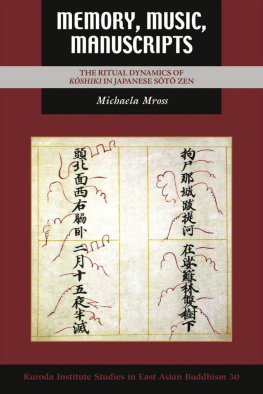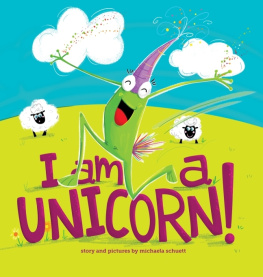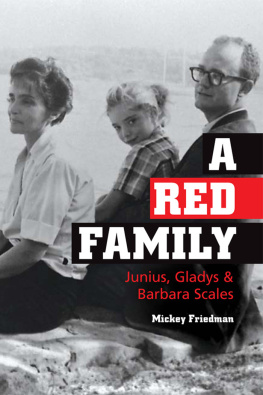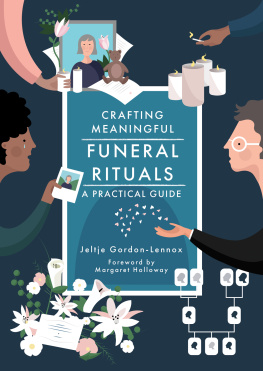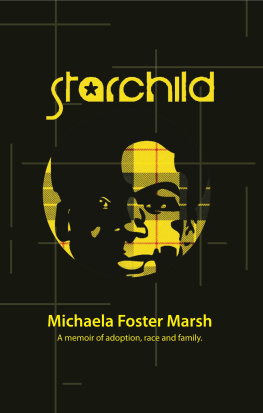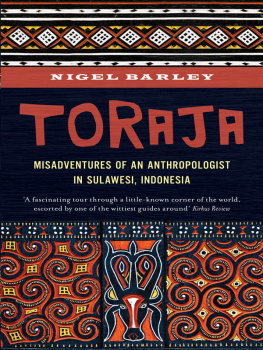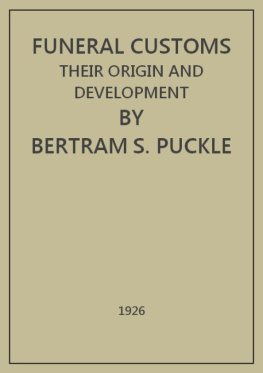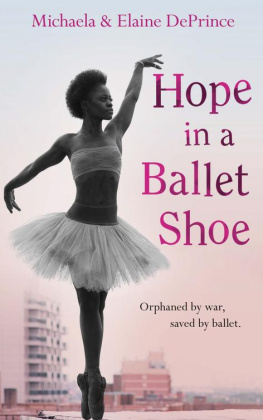Contemporary Funeral Rituals of Sadan Toraja
From Aluk Todolo to New Religions
Michaela Budiman
Reviewed by:
Ing. Mgr. Zorica Dubovsk (Prague)
Prof. Rudolf Mrzek, Ph.D. (Michigan)
PhDr. Tom Petr, Ph.D. (Prague)
Edited by Petra Blkov
Layout by Jan erch
Typeset DTP Karolinum
First edition
Charles University in Prague, 2013
Text Michaela Budiman, 2013
Translation Barbora tefanov, Keith Jones, 2013
Cover photo Michaela Budiman, 2013
Illustrations Polina Kazakova, 2013
Photographs Michaela Budiman, Martin Tok (photographs nos. 6, 7, 26),
Stanislaus A. Dammen (photograph no. 28)
ISBN 978-80-246-2228-6
ISBN 978-80-246-2456-3 (online: pdf)
ISBN 978-80-246-3059-5 (ePub)
ISBN 978-80-246-3060-1 (Kindle)
Charles University in Prague
Karolinum Press 2013
http://www.cupress.cuni.cz
To my parents
Acknowledgements
This work was possible thanks to the selfless help of several people. However, whatever mistakes appear are mine alone. Firstly I would like to express my gratitude to my supervisor, Dr. Alena Oberfalzerov, for her consultancy, kindness and the time she dedicated to my intellectual pursuits. I wish to thank my teacher, Ing. Mgr. Zorica Dubovsk, who motivated me to follow a more profound study of Indonesia, and who also inspired me to love this wonderful country. My deep gratitude goes to my family for supporting me both materially and emotionally throughout my studies at the university. In particular, I would like to thank my mother, Dr. Katarna Rybkov, for her assistance with the final proofs of the present text, and my husband, Erik Herlambang Satrio Budiman, for his help with the transcription and analysis of the interviews I recorded in Indonesia. I would also like to thank my friends, Mgr. Ivan Hartmann, for editing the work in Czech and Karen McIntyre, for proofreading the English text. I am also deeply grateful to many other friends for the support they offered, as well as for their assistance with the final adjustments.
Naturally, the present work could not have materialized without the contribution of hundreds of Indonesians, and the Toraja in particular, whom I met during my field research, and who have helped me in countless ways. My gratitude goes to my main informant, Tato Dena, an exceptional figure, who was willing to share with me part of his store of priceless knowledge regarding Toraja culture, and whose general approach to life provided a lesson in its own right and enriched me in human terms. Another key figure was the Catholic Priest, Drs. Lucas Paliling, LicIC. Apart from being a vital source of information, he provided me with a moral base to fall back on during my sojourn in Indonesia. Among the other people to whom I am indebted for advice are the Catholic priests, Drs. Stanislaus A. Dammen, MPS, MA. and Drs. Yohanes Manta Rumengan. Additionally, I would like to thank the family of Stanislaus Dammen for their kindness and hospitality. I also wish to thank Drs. Paulus Palondongan, MM and Paulus Pasang Kanan, a number of relatives of Father Lucas, STIKPAR students, Mrs. Lily and other Toraja, whom for obvious reasons I cannot list here in entirety.
Kurre sumanga!
1
Introduction
1.1 Themes and Objective of the Present Work
The present work discusses the Toraja ethnic group, who inhabit the Indonesian island of Sulawesi, and who, until the arrival of the first Dutch missionaries at the beginning of the 20th century, had essentially been cut off from the rest of the world. It can thus be said that until that point, the Toraja represented an isolated socio-cultural system. The present work draws on the field research of the author, which focused on the study of the most important contemporary Toraja ritual the funeral and furthermore on identifying and documenting the changes that have affected Toraja society as a result of their embrace of Christianity during the past century. The Toraja region, which is at present populated by the adherents of various Christian denominations, Islam, and the autochthonous religion Aluk Todolo (lit. the religion of the ancestors), offered an exceptionally rich and varied source material for study. The result of this field research is the present work, which aims to analyse the material gathered and to present a description of the formal and principal shifts expressed in the traditional rituals, which reflect seminal changes in terms of the role of religion. The book points out how Christianity, which has been adopted relatively recently, is incorporated into the indigenous religion and the customary law adat, which is derived from it. The present work ventures to explain why in less than a hundred years, almost 90 % of the population converted from Aluk Todolo, mainly to Christianity, also describing the process of conversion, and the extent to which (and in which localities) the new religion most visibly affected the form of modern-day rituals. The opinions of both Christians and minority adherents of Aluk Todolo are noted, especially with regard to the current situation, where funeral rites in particular represent a curious syncretic phenomenon, reflecting the societal changes that have taken place.
The body of textual, oral and audio-visual documentation collected by the author is unique, chiefly in that it includes interviews with one of the last living experts on the traditional Toraja religion. The present work offers the first processing of the material thus gathered, which is now ready for further expert review. It can be used for instance for linguistic analysis, or as a study from the perspective of the ethnography of communication, or in comparison with other ethnicities undergoing similar changes.
1.2 Structure of the Present Work
The present work is divided into two parts, logically interconnected, and sub-divided into chapters. The results of the research are summarized in the Conclusion.
The first part, The Foundations of Toraja Culture, is subdivided into three chapters surveying various aspects of Toraja culture. Chapter One, entitled Tana Toraja and Its Inhabitants, outlines the origin of the Toraja, as well as the etymology of the term Toraja itself. Given the cultural differences as well as the geographical remoteness of the country, it also presents brief essential information on the geography, climate and economic situation of the region. This is followed by an introduction into the Toraja language and available literature on the Toraja language and cultural traditions; the chapter closes by citing the historical milestones of the Toraja ethnic group. the house, as well as the role of buffaloes, an essential fixture in most Toraja funerals.
The core of the work is presented in the second part of the book, entitled Forms of Funeral Rituals in the Past and Today, which is based almost exclusively on my own field research. The first chapter General Information on Funeral Rites outlines what happens to the soul of the deceased according to the indigenous Toraja belief, the ways in which the family of the deceased administers to the body, and the extent to which the social status and financial situation of the family influence the form and duration of this most important Toraja ritual in the present day. Next is a general outline of the funeral site and the accompanying rituals. The following chapter





